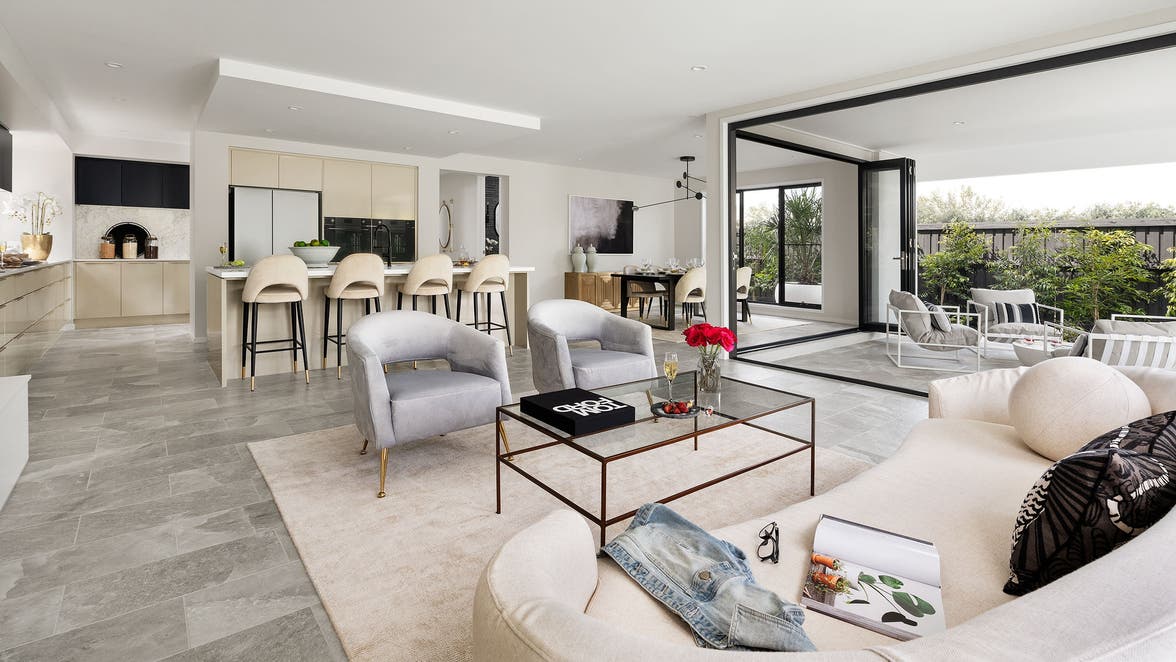Open floorplans started as an architectural trend that soon blossomed into a mainstay in today’s modern house designs. It’s called “great room” for good reason — a shared space that brings families, friends, and guests together.
What is an open floorplan?
An open floorplan, or home plan, combines two or more communal rooms by removing the walls between them and forming a larger shared space within the home. The most common combination is the great room which joins the living room, dining area, and kitchen all together.
The rise of open floorplans put a halt to the kitchen being seen as a service area. In traditional floorplans, you’ll find the kitchens at the back of the house, off-limits to guests.
The 20th century saw the adoption of more relaxed lifestyles and less formal social interactions. Populations grew and residential lots decreased in size, so rooms became less limited to a specific purpose. The dining room was no longer simply a place to eat — children also used it for studying and playing. This began blurring the need for physical boundaries within the house, oiling the works for what we now know as the open plan.
What are the usual open home plan combinations?
Dining and living rooms
This is where the dining and living rooms are in the same space without a partition. Homeowners visually divide the two with the use of rugs, paint colours, handrails, or furniture.
Kitchen and dining room
Another common open plan combination is joining the kitchen and dining area. It creates an easy, free and natural flow from the kitchen, where the food is prepared, to the dining area, where everyone can enjoy a meal together. These two areas are often separated by a kitchen island.
Dining, kitchen and living rooms
The trifecta that forms the great room. Connecting these three rooms creates an open, inviting, and spacious area. With the creative use of rugs, modular furniture, and staircases, homeowners can designate rooms without ever using a wall.
What makes open plan living great?
The advantages of adopting an open layout centre around people and their movement within the home.
Easy traffic flow
Open plans allow people to move around freely. Without walls and doors to break up the traffic flow at home, you can create an illusion of a larger space that’s easy to move around in. And if you follow Feng Shui principles, remember to keep your home clutter-free to invite positive energy and let it flow within your home.
Family-friendly
Instead of being cooped up in individual rooms, a shared space invites members of the family to come together and spend some time with each other. It’s also a winner for families with kids as open floorplans allow parents to keep their children within line of sight while going about their chores.
Good for entertaining guests
Open floorplans are social and great for having guests over. The layout is akin to an invisible guide that helps them move around; they will still be within arm’s reach — even when you’re still busy in the kitchen!
Welcomes natural light and promotes airflow
An abundance of natural light can make your home feel brighter and larger. Having walls can block the sunlight coming into your house or contain it in certain areas. It can also obstruct air circulation within the home. An open plan presents a straightforward solution: an improved distribution of sunlight and promotion of airflow.
Layout flexibility and multi-functionality
The lack of partitions makes it easy to move furniture and appliances around. You can also easily convert certain areas to a specific room type according to need (e.g., family room, home office, entertainment area, etc).
Improved resale value
Open plans exude modern-day living, so it’s no surprise that it’s highly sought-after amongst homebuyers. This gives your home advantage when it comes to a resale should you sell it down the line.
What are some challenges to adopting an open floorplan?
Costly heating and cooling
Because of a larger communal area, heating and cooling the entire space (instead of separating them into rooms) may turn out more expensive. If you’re looking for budget-friendly ways of adopting this layout, maximise your use of natural light and thermal insulation to lessen your reliance on heating and cooling systems.
Tricky noise control
Noise is an inevitable downside to open plans. If everyone is in the great room at the same time, getting some peace and quiet might be challenging. You’re better off spending your me-time elsewhere in the house!
Lack of privacy
The absence of partition walls won’t help with privacy either. If you find yourself in a work-from-home setting, an open layout may not be conducive to productivity.
What’s the verdict?
If you’re after a modern-style interior that’s bright, spacious and inviting, an open floorplan might be the one for you. The open concept isn’t just a floorplan, it’s also a way of living that instils a sense of togetherness in each member of the household. It isn’t called open plan living for no reason!
Need open plan inspiration? Explore our home designs or visit one of our stunning display homes today!

